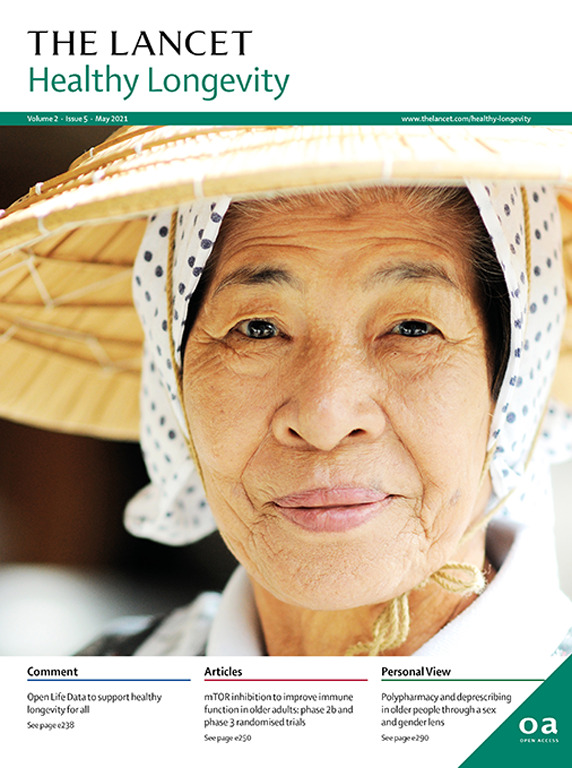口腔健康对日本老年人功能障碍和死亡率的影响:一项队列研究。
IF 13.4
Q1 GERIATRICS & GERONTOLOGY
引用次数: 0
摘要
背景:口腔健康曾显示与功能性残疾和死亡率有关。我们旨在利用生存分析法探讨口腔健康状况的各个方面与功能性残疾和死亡率之间的关系,以及这些方面对结果影响的相对大小:我们获得了日本岛根县 75 岁及以上老年人的数据,他们在 2016 年 4 月 1 日至 2022 年 3 月 31 日期间根据日本的长寿医疗制度保险体系至少接受了一次口腔健康检查。数据缺失者或基线时有功能障碍者被排除在外。作为检查的一部分,牙医或牙科保健师对口腔健康状况的 13 个方面进行了评估(采用日本牙科协会和日本厚生劳动省提供的方案):剩余牙齿数量、主观咀嚼能力、客观咀嚼能力、牙周组织状况、功能性吞咽困难、舌头活动能力、发音能力、口腔卫生、蛀牙数量、上颚和下颚假牙不适应(单独考虑)、口腔粘膜疾病和口干。多变量考克斯比例危险模型用于分析口腔健康各方面与功能性残疾和死亡率之间的关系,完全调整模型对性别、年龄、体重指数、病史或根据这些协变量得出的倾向得分进行了调整。通过计算人口可归因分数(PAF)来评估这些口腔健康状况对结果发生的不同影响:在研究期间接受口腔健康检查的 24 619 人中,有 21 881 人被纳入功能性残疾分析(男性 9175 人 [41-93%],女性 12 706 人 [58-07%],平均年龄 78-31 岁 [SD 2-88]、平均随访时间为 41-43 个月 [20-80]),22747 人被纳入死亡率分析(男性 9722 人 [42-74%],女性 13025 人 [57-26%],平均年龄 78-34 岁 [2-89],平均随访时间 42-63 个月 [20-58])。在完全调整模型中,口腔健康状况的所有 13 个方面都与死亡率的发生有显著关联,而功能性残疾与 11 个方面(不包括口腔黏膜疾病和口腔干燥)有关。根据 PAF,在所有评估的口腔健康状况中,客观咀嚼表现对功能性残疾(PAF 最低的为 23-10% [95% CI 20-42-25-69],次低的为 10-62% [8-18-12-99])和死亡率(16-47% [13-44-19-40] 和 8-90% [5-87-11-82])的影响最大:口腔健康的各个方面都与死亡率和功能障碍有关。老年人保持良好的口腔健康可能有助于减少这些结果:无。本文章由计算机程序翻译,如有差异,请以英文原文为准。
Effect of oral health on functional disability and mortality in older adults in Japan: a cohort study
Background
Oral health has previously shown associations with functional disability and mortality. We aimed to explore the associations of various aspects of oral health status with functional disability and mortality using survival analysis, as well as the relative magnitudes of the impact of these aspects on outcomes.
Methods
We obtained data for individuals aged 75 years and older in Shimane, Japan, who had at least one oral health check-up between April 1, 2016, and March 31, 2022 under Japan’s long-life medical care system insurance system. Those with missing data or with functional disability at baseline were excluded. 13 aspects of oral health status were assessed by dentists or dental hygienists as part of the check-up (using protocols provided by the Japan Dental Association and the Japanese Ministry of Health, Labour and Welfare): number of remaining teeth, subjective masticatory performance, objective masticatory performance, periodontal tissue status, functional dysphagia, tongue mobility, articulation, oral hygiene, number of decayed teeth, inadaptation of dentures of the upper jaw and lower jaw (considered separately), oral mucosal disease, and dry mouth. Multivariate Cox proportional hazards models were used to analyse the associations between each aspect of oral health and functional disability and mortality, with fully adjusted models adjusting for sex, age, BMI, medical history, or a propensity score derived from these covariates. Population-attributable fractions (PAFs) were calculated to assess the differential impacts of these oral health status aspects on outcome occurrence.
Findings
Of the 24 619 individuals who had an oral health check-up during the study period, 21 881 individuals were included in the analysis of functional disability (9175 [41·93%] men, 12 706 [58·07%] women, mean age 78·31 years [SD 2·88], mean follow-up 41·43 months [20·80]), and 22 747 individuals in the analysis of mortality (9722 [42·74%] men, 13 025 [57·26%] women, mean age 78·34 years [2·89], mean follow-up 42·63 months [20·58]). All 13 aspects of oral health status showed significant associations with the occurrence of mortality, while functional disability was associated with 11 aspects (excluding oral mucosal disease and dry mouth) in the fully adjusted model. Based on PAFs, of all oral health aspects assessed, objective masticatory performance had the greatest impact on both functional disability (PAF 23·10% [95% CI 20·42–25·69] for the lowest and 10·62% [8·18–12·99] for the second-lowest quartile of performance) and mortality (16·47% [13·44–19·40] and 8·90% [5·87–11·82]).
Interpretation
Various aspects of oral health are associated with mortality and functional disability. Maintaining good oral health in older adults might help to reduce these outcomes.
Funding
None.
求助全文
通过发布文献求助,成功后即可免费获取论文全文。
去求助
来源期刊

Lancet Healthy Longevity
GERIATRICS & GERONTOLOGY-
CiteScore
16.30
自引率
2.30%
发文量
192
审稿时长
12 weeks
期刊介绍:
The Lancet Healthy Longevity, a gold open-access journal, focuses on clinically-relevant longevity and healthy aging research. It covers early-stage clinical research on aging mechanisms, epidemiological studies, and societal research on changing populations. The journal includes clinical trials across disciplines, particularly in gerontology and age-specific clinical guidelines. In line with the Lancet family tradition, it advocates for the rights of all to healthy lives, emphasizing original research likely to impact clinical practice or thinking. Clinical and policy reviews also contribute to shaping the discourse in this rapidly growing discipline.
 求助内容:
求助内容: 应助结果提醒方式:
应助结果提醒方式:


